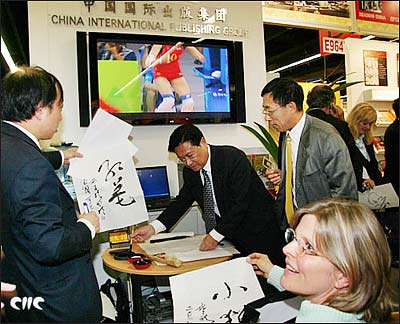Chinese characters evolved from pictures and signs, and the
Chinese art of calligraphy developed naturally from its unique
writing system. Every dynasty had its great calligraphers whose
styles came to symbolize their age, and the Chinese people's love
of calligraphy stems from that tradition.
Different from Western oil painting, traditional Chinese
painting is characterized by unique forms of expression. Its roots
can be traced back to paintings on Neolithic pottery 6,000-7,000
years ago. Since similar tools were used to draw the lines of the
earliest painting and writing, painting and calligraphy are said to
share the same origins. Chinese paintings usually include poetry or
calligraphy, thus the three are integrated, providing a richer
aesthetic experience. Figure, landscape, and flower-and-bird
paintings are major traditional painting genres, still highly
valued today.
 |
Contemporary painting and calligraphy are still very active. The
National Art Museum of China and others hold individual or joint
exhibitions every year, and exhibitions of traditional Chinese
painting have been held in Japan, the Republic of Korea, the United
States, Canada and Europe. Chinese artists have also made
remarkable progress in Western-style oil painting, woodcut and
watercolor and many have created works that combine traditional
Chinese style with Western techniques, adding splendor to both
forms. New media art works, including video, digital, animated and
audio art, are frequently seen at domestic and overseas
exhibitions.
In March 1994, the newly founded China Guardian Auctions held an
auction of Chinese painting, calligraphy and oil painting at
Beijing's Great Wall Sheraton Hotel, resulting in transactions
totaling 14.2 million yuan and setting a record for mainland
China's artwork auctions. The 2005 autumn auction raised nearly 700
million yuan in transactions, almost 50 times the 1994 total. Art
galleries too are catching up with international practice. Beijing,
Shanghai and Guangzhou take turns to host an annual art exposition,
adding a new channel for trading in art; the Shanghai Art Fair
boasts the greatest variety of artworks of any fair in Asia.